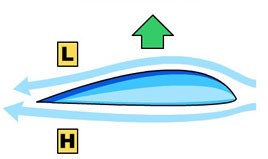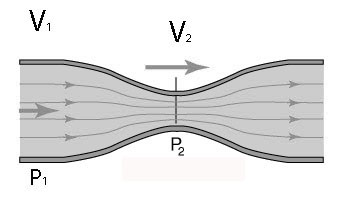WHAT IS BERNOULLI'S PRINCIPLE-- Fluids in Motion
Bernoulli's principle states that for a fluid with zero viscosity, an increase in the speed of the fluid occurs simultaneously with a decrease in pressure or a decrease in the fluid's potential energy. The principle is named after Daniel Bernoulli who published it in his book Hydrodynamica in 1738.
Video demonstrating Bernoulli's principle using paper -- the air that travels across the top of the paper is moving faster than the air under the paper. The pressure in the moving stream is less than the pressure under the paper.
Bernoulli's principle can be derived from the principle of conservation of energy. This states that: in a steady flow, the sum of all forms of energy in a fluid along a streamline (family of curves that are instantaneously tangent to the velocity vector of the flow) is the same at all points on that streamline. This requires that the sum of kinetic energy, potential energy and internal energy remains constant. This constraint gives rise to a relationship between the velocity (speed) of the fluid, its pressure, and its elevation (relative height). For the mathematical explanation see: Bernouillis Equation Thus an increase in the speed of the fluid occurs with a simultaneous decrease static pressure, potential energy and internal energy.
Since there must be conservation of energy: Increased fluid speed V2 with decrease in internal pressure P2 ----(V2>V1 and P2<P1) |
Bernoulli and Flight --- What contributes to lift in an airplane?
Aircraft wing geometry has a large effect on the amount of lift The wings of the vehicle have aerofoil* shaped cross-sections and for the given flow conditions the aerofoil shapes will create a pressure difference between upper and lower wing surfaces. There will be a high pressure region underneath and a very low pressure region on top.
*An aerofoil is the term used to describe the cross-sectional shape of an object that, when moved through a fluid such as air, creates an aerodynamic force
 image from NASA.gov
image from NASA.gov
Air flows faster over the top of the wing decreasing the air pressure. Airflow is slower underneath the wing so air pressure is greater there contributing to lift.
The fluid on top of the wing is accelerated and the fluid on the bottom of the wind is slowed down compared to velocity of the aircraft itself because the wing geometry and angle narrows the flow area above the wing and widens the flow area below the wing from http://physics.stackexchange.com/questions/13030/why-does-the-air-flow-faster-over-the-top-of-an-airfoil.
The concept of lift however is very complicated and cannot be explained alone using Bernouilli's principle. Newton's laws are typically preferred over the Bernoulli principle to explain lift. See References and Readings for further discussion.
References and Readings
Aviation Knowledge -- Aerofoil
Lesson: Bernoulli's Principle K-12
Bernoulli or Newton's Laws for Lift?
Related Activies
- Mass Volume Density
- Molecular Modeling-- An NGSS Activity
- Water and Ice Module
- States of Matter
- How do molecules of solids, liquids and gas behave differently?
- Science of Fluids
- What is Humidity
- Buoyancy and Archimedes Principle
- Speed Velocity and Acceleration
- Gifted and Talented STEM
- EDinformatics Science Challenge
- How does a battery work?
